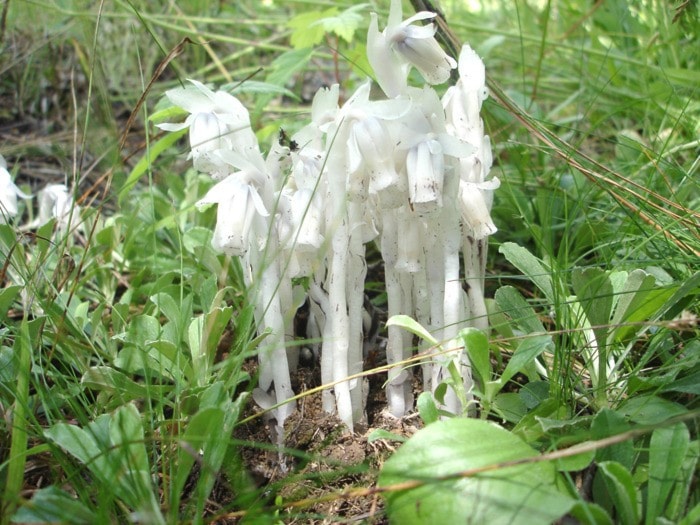This past summer’s extra moisture and cool start produced a later than usual bumper crop of late-blooming wildflowers. Many plants that had not bloomed in previous dry years were “resurrected” into robust seed producing plants. Some of my favourite plant species were no exception.
In early August, I came upon what seemed larger groups and colonies of those plants that live without chlorophyll. For the most part they thrive best in shade or partial shade and can do that because they do not directly depend on sunlight to obtain nourishment. Chlorophyll enables plants to manufacture their own food, resulting in green foliage. On the contrary, plants without chlorophyll obtain their nourishment from decaying plant matter. We call them saprophytes.
Indian pipe seems to grow best in almost total shade. I find it most often in dark evergreen forest. Its pallid white cast contrasts sharply to the drab, dark forest floor. The eight-inch stalk produces a single flower that faces down initially but later, when containing mature seeds, faces upward. Indian pipe plants usually appear in tight groups that pop up all over a favoured area of forest flower. If unacquainted with Indian pipe, because it is not green, one might think it is some sort of mushroom. It is often found growing in mushroom’s favourite haunts. Indian pipe has given rise to the name of the small family to which it belongs — the Indian pipe family. This few-membered family also includes candy stick, cone plant (gnome plant), and pine sap (many-flowered Indian pipe).
Another flower personality, living without chlorophyll that aids a plant in manufacturing its own food, is pine drops. There seemed to be more than usual numbers of pine drops this summer. I came upon a colony of this tall plant spire that must have included a hundred plants. There must have been lots of decaying organic matter in this niche. Each reddish stalk bore up to 50 flowers. Many single spires were over three feet tall. One past spring, I found a dried stalk from the previous year that was five feet in height. Pine drops are most easily found in partial or dappled shade on northeast-facing woodland slopes where adequate moisture is available. In this kind of neighbourhood, fairy slipper, a pink-flowered orchid, may also be found (keep that secret).
Some of the orchids are saprophytes. (Is that a new word for you?) Colonies of striped coral root, belonging to the orchid family, were also abundant in early August. Along with spotted coral root and northern coral root (yellow coral root), the striped has that classic orchid-like flower. Our forests contain a significant number of orchids that do their best in partial shade, which is getting hard to come by.
In one loose group of shade-loving striped coral root I found there were about 30 plants. Both this orchid and the spotted coral root have red, pink and/or white in the flowers. In the striped, the top of the flower is striped, and in the spotted, the lower lip has red spots on white.
Last spring, we visited the broomrape, which has a unique flower, and its habit. It does depend on other plants, living plants like large-leaved alum and Indian paintbrush, but since its food is living, the broomrape is parasitic, like some orchids.
Thanks for letting me introduce you to Indian pipe and some plants that share its neighbourhood and food source — decaying plant matter.
Ed McMackin is a biologist by profession but a naturalist and hiker by nature. He can be reached at 250-866-5747.
